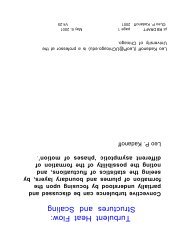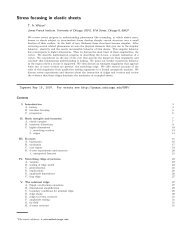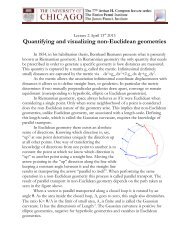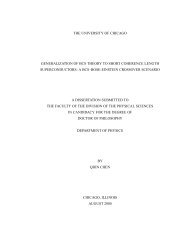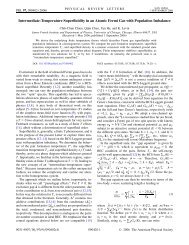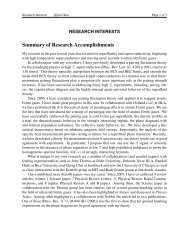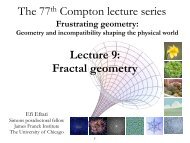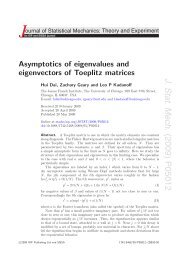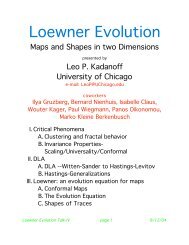Murder on...V1.2 - James Franck Institute - University of Chicago
Murder on...V1.2 - James Franck Institute - University of Chicago
Murder on...V1.2 - James Franck Institute - University of Chicago
Create successful ePaper yourself
Turn your PDF publications into a flip-book with our unique Google optimized e-Paper software.
<str<strong>on</strong>g>Murder</str<strong>on</strong>g> <strong>on</strong> the New Jersey Express<br />
by<br />
Leo P. Kadan<strong>of</strong>f<br />
The <strong>James</strong> <strong>Franck</strong> <strong>Institute</strong><br />
The <strong>University</strong> <strong>of</strong> <strong>Chicago</strong><br />
5640 S. Ellis Avenue<br />
<strong>Chicago</strong> IL 60637 U.S.A.<br />
E-mail: LeoP@Uchicago.edu<br />
Many physicists have been very disturbed by the fabricati<strong>on</strong> <strong>of</strong><br />
scientific data at Lucent’s Bell Laboratories. The fabricati<strong>on</strong> was c<strong>on</strong>firmed<br />
by the Beasley panel, commissi<strong>on</strong>ed by Lucent1. This kind <strong>of</strong> fraud is the<br />
scientific equivalent <strong>of</strong> murder, and perhaps it should be described within<br />
the metaphor <strong>of</strong> the detective novel. In this case, perhaps the most<br />
relevant model is the Agatha Christie story “<str<strong>on</strong>g>Murder</str<strong>on</strong>g> <strong>on</strong> the Orient<br />
Express”.2 A murder is committed <strong>on</strong> an isolated, snowbound train<br />
c<strong>on</strong>taining a dozen or more suspects. The great detective, Hercule Peroit<br />
happens to be aboard. The head <strong>of</strong> the railway asks him to investigate.<br />
The Beasley commissi<strong>on</strong> was brought in by Lucent’s management after<br />
they had been alerted by outsiders. It had been clear for some time that<br />
there were difficulties with reproducing some <strong>of</strong> the lab’s organic material<br />
studies. These papers reported remarkable, beautiful c<strong>on</strong>clusi<strong>on</strong>s related<br />
to the applicati<strong>on</strong>s <strong>of</strong> organic materials which might be fashi<strong>on</strong>ed into<br />
important tools for nanotechnology. The commissi<strong>on</strong> was called because <strong>of</strong><br />
evidence <strong>of</strong> data fabricati<strong>on</strong>. Identical curves appeared in papers<br />
describing different experiments. After a careful investigati<strong>on</strong> <strong>of</strong> the<br />
relevant Bell-lab science the commissi<strong>on</strong> came to a sharp c<strong>on</strong>clusi<strong>on</strong>: Dr.<br />
J<strong>on</strong> Hendrik Schön, acting al<strong>on</strong>e, fabricated the data in at least sixteen<br />
scientific papers. To support his papers, Dr. Schön could supply no lab<br />
books, nor original data, nor samples, nor computer records. Nothing.<br />
Before proceeding further, we might wish to ask about the seriousness<br />
<strong>of</strong> this event. Could this fabricati<strong>on</strong> be viewed as a “victimless” crime with<br />
no worse effect than to distort the pattern <strong>of</strong> scientific spending <strong>of</strong> a large<br />
corporate laboratory. As it turns out, there are additi<strong>on</strong>al victims. Schön<br />
has been fired. His supervisor and frequent coauthor, Pr<strong>of</strong>essor Betram<br />
Batlogg, has been left in a kind <strong>of</strong> limbo by the Beasley report: neither<br />
<str<strong>on</strong>g>Murder</str<strong>on</strong>g><strong>V1.2</strong> DRAFT page 1 February 21, 2003 ©Leo Kadan<strong>of</strong>f 2002
indicted nor ex<strong>on</strong>erated. Both authors might have hoped for a Nobel prize<br />
as the outcome <strong>of</strong> their joint work. This is not to be. Many different<br />
laboratories c<strong>on</strong>tain disappointed scientists who unsuccessfully worked to<br />
reproduce the experiments, to explain them theoretically, and to build<br />
up<strong>on</strong> them. Many pers<strong>on</strong>-years <strong>of</strong> scientific effort have been wasted.<br />
But the effects extend further. The entire system <strong>of</strong> data depositi<strong>on</strong> and<br />
archiving at Bell has been shown to fail. The reputati<strong>on</strong> <strong>of</strong> the laboratory,<br />
scientists and managers, has suffered. People are worried about the<br />
possible closure <strong>of</strong> the entire scientific effort.<br />
The effects will extend bey<strong>on</strong>d Bell. Accounts <strong>of</strong> scientific outcomes<br />
have been discredited in much the same sense as corporate accounting.<br />
Despite the misbehavior <strong>of</strong> corporati<strong>on</strong>s, our society needs teleph<strong>on</strong>e,<br />
energy, and investment companies. However, the society does not in equal<br />
measure need research in the physical sciences. This awful event<br />
occurred precisely because Bell Labs was in decline as its parent<br />
corporati<strong>on</strong>, al<strong>on</strong>g with others, decided that research in physical sciences<br />
was a luxury. We might expect a large cutback <strong>of</strong> funding for our kinds<br />
<strong>of</strong> research as a result <strong>of</strong> this affair. Many more people than Schön will<br />
find themselves without jobs.<br />
Bey<strong>on</strong>d that, many <strong>of</strong> us feel that this violati<strong>on</strong> <strong>of</strong> our ideals cheapens<br />
the entire scientific calling.<br />
Now that we have explored the results <strong>of</strong> the crime, let us further<br />
follow the detective story analogy. Let us ask about motive. Who would<br />
benefit from the successful perpetrati<strong>on</strong> <strong>of</strong> this fraud? The authors <strong>of</strong> the<br />
papers might have expected to reap rewards from this important<br />
c<strong>on</strong>tributi<strong>on</strong> to science and technology. Other scientists and management<br />
at Bell would benefit too. A success <strong>of</strong> this magnitude might help keep the<br />
laboratory alive, even in the teeth <strong>of</strong> a factor <strong>of</strong> forty reducti<strong>on</strong> <strong>of</strong> the<br />
value <strong>of</strong> stock in the parent corporati<strong>on</strong>. The rest <strong>of</strong> us in science? Us too.<br />
We have managed to keep our disciplines funded, to employ faculty,<br />
postdocs, and graduate students, <strong>on</strong> the basis <strong>of</strong> an implicit or explicit<br />
promise to deliver important items <strong>of</strong> technology. If they were real, the<br />
Schön “discoveries” would provide all <strong>of</strong> us with important arguments to<br />
support things we hold dear.<br />
That takes care <strong>of</strong> motive. Imagine that great detective talks to each <strong>of</strong><br />
us and tries to tease out the truth from the different stories we tell. All<br />
<str<strong>on</strong>g>Murder</str<strong>on</strong>g><strong>V1.2</strong> DRAFT page 2 February 21, 2003 ©Leo Kadan<strong>of</strong>f 2002
who are seen to lie are suspects. Which <strong>of</strong> us has not argued for the<br />
importance <strong>of</strong> our own work or the work <strong>of</strong> our group or pr<strong>of</strong>essi<strong>on</strong>, and<br />
reached just a tiny bit bey<strong>on</strong>d the dem<strong>on</strong>strably true? In my own area <strong>of</strong><br />
c<strong>on</strong>densed matter physics, we have cold fusi<strong>on</strong>, s<strong>on</strong>oluminesence, the<br />
theory <strong>of</strong> high temperature superc<strong>on</strong>ductivity, and complexity theory--no<br />
<strong>on</strong>e <strong>of</strong> which has yet fulfilled the high promises made for them. The more<br />
recent buzz-words: micr<strong>of</strong>luidics, self-assembly, quantum computing, and<br />
nanotechnology, are now being sold as if they were promises rather than<br />
just possibilities. Journals, preprints, publicity releases, and public<br />
statements all put the promising features <strong>of</strong> any novelty <strong>on</strong>to their covers<br />
and abstracts. Editors, scientists, and publicity specialists then reserve the<br />
words <strong>of</strong> cauti<strong>on</strong> for the last paragraph or for a later publicati<strong>on</strong>. Crucial<br />
details which might enable people to check or reproduce published work<br />
<strong>of</strong>ten get left out entirely.<br />
Another kind <strong>of</strong> lie is told by authors who fail to fulfill their<br />
resp<strong>on</strong>sibilities. People accept the title <strong>of</strong> “author” without being fully<br />
aware <strong>of</strong> all aspects <strong>of</strong> the work they have signed. This outcome is<br />
understandable when a junior author adds a specialized expertise to a<br />
larger work. This author could meet his or her resp<strong>on</strong>sibilities by asking<br />
that the introducti<strong>on</strong> describe the different imputs <strong>of</strong> the various author.<br />
A senior author should lead the way in doing this, particularly since-without<br />
further comment--the scientific world should assume that the<br />
senior pers<strong>on</strong> takes resp<strong>on</strong>sibility for the entire work. He or she can then<br />
be expected to have d<strong>on</strong>e all the reas<strong>on</strong>able checks which will ensure that<br />
the paper has a proper chance <strong>of</strong> being right. Overenthusiastic people<br />
<strong>of</strong>ten seek to “improve” or “select” or “smooth” their data. Competitors are<br />
<strong>of</strong>ten not given due credit. Senior authors should see that all these kinds <strong>of</strong><br />
lies do not occur. If the presence <strong>of</strong> any author <strong>on</strong>ly represents a vague<br />
c<strong>on</strong>necti<strong>on</strong> with the work, perhaps indicating <strong>on</strong>ly administrative or<br />
fundraising resp<strong>on</strong>sibility, this author is taking the reading public for a<br />
ride. He or she then runs the grave risk <strong>of</strong> being in turn taken <strong>on</strong> a ride<br />
into scientific disgrace.<br />
The last two paragraphs describe the lies which tempt us all: editors,<br />
authors, scientists, technical managers, grant administrators. If we<br />
succumb to the temptati<strong>on</strong> to lie, we will not <strong>on</strong>ly excite the suspici<strong>on</strong> <strong>of</strong><br />
the detective. We will be setting an example in which lies are the norm<br />
rather than an excepti<strong>on</strong>. We will help c<strong>on</strong>vince people that an adjustment<br />
<str<strong>on</strong>g>Murder</str<strong>on</strong>g><strong>V1.2</strong> DRAFT page 3 February 21, 2003 ©Leo Kadan<strong>of</strong>f 2002
<strong>of</strong> the audit <strong>of</strong> our scientific work to make the bottom line look better is<br />
the expected behavior. Most <strong>of</strong> us are <strong>on</strong>ly given to little lies. But, even<br />
our little lies each c<strong>on</strong>tribute, just a little, to increase the probability <strong>of</strong><br />
crimes like the <strong>on</strong>e committed <strong>on</strong> the New Jersey express.<br />
The great detective might notice that, despite these lapses, our<br />
community does maintain a deep and essential respect for truth, especially<br />
in the c<strong>on</strong>tent rather than the form <strong>of</strong> science. Our methods do, after a<br />
while, strain out both fraud and scientific errors. The community outside <strong>of</strong><br />
Bell has rejected the work <strong>of</strong> Schön in a timely fashi<strong>on</strong>. Earlier the<br />
community also rejected the reports <strong>of</strong> cold fusi<strong>on</strong> and the wilder<br />
interpretati<strong>on</strong>s <strong>of</strong> s<strong>on</strong>oluminesence. We can be mostly pleased with the<br />
acti<strong>on</strong> <strong>of</strong> our filters. After filtering, the remaining scientific material is a<br />
solid core <strong>of</strong> observati<strong>on</strong> and theory which is, in the main, true. Since the<br />
art <strong>of</strong> the ficti<strong>on</strong>al detective is built up<strong>on</strong> the scientific sifting <strong>of</strong> evidence,<br />
Peroit might well feel respect for these essential goals and achievements <strong>of</strong><br />
our pr<strong>of</strong>essi<strong>on</strong>.<br />
In the book, Hercule Poirot carefully investigates the murder <strong>on</strong> the<br />
Orient Express, and “solves” it by <strong>of</strong>fering two quite different explanati<strong>on</strong>s.<br />
In <strong>on</strong>e, by far the most plausible, almost all <strong>of</strong> the possible suspects acted<br />
together to avenge an earlier crime and rid the world <strong>of</strong> an evil pers<strong>on</strong>.<br />
The other soluti<strong>on</strong> was that an outsider, acting al<strong>on</strong>e, had appeared <strong>on</strong> the<br />
scene, d<strong>on</strong>e the murder, and disappeared into a snowdrift, leaving no<br />
tracks. Despite the glaring inc<strong>on</strong>sistency in the latter story, the detective<br />
and his employer pick it as the <strong>on</strong>e which they will present to the police<br />
and the world at large. So Poirot is not so committed to truth after all.<br />
Now back to science. We live in the real world. We should not expect<br />
Periot’s easy soluti<strong>on</strong>s. We cannot believe that this fraud results from a<br />
c<strong>on</strong>spiracy <strong>of</strong> many equally guilty actors. Nor can a full explanati<strong>on</strong> base<br />
itself up<strong>on</strong> the isolated acti<strong>on</strong> <strong>of</strong> a single wicked individual, coming from<br />
outside the system. But anyhow, soluti<strong>on</strong>s are for detective stories, not<br />
life. We cannot know what really happened. Instead <strong>of</strong> fruitlessly asking<br />
whod<strong>on</strong>eit, we should ask how our pr<strong>of</strong>essi<strong>on</strong> might get better outcomes in<br />
the future.<br />
Certainly we need to define more precisely the norms <strong>of</strong> our pr<strong>of</strong>essi<strong>on</strong>.<br />
The little homily about authorship given above is a small essay in that<br />
directi<strong>on</strong>. But no set <strong>of</strong> written words can replace the working <strong>of</strong> a healthy<br />
<str<strong>on</strong>g>Murder</str<strong>on</strong>g><strong>V1.2</strong> DRAFT page 4 February 21, 2003 ©Leo Kadan<strong>of</strong>f 2002
society.<br />
We can make our laboratories healthier and more supportive <strong>of</strong> truth<br />
by making them more open and having our scientific work be more <strong>of</strong> a<br />
cooperative endeavor. Each <strong>of</strong> us should encourage our colleagues to see<br />
us at work, and to share in and criticize that work. We should each share in<br />
our colleagues’ activities. An atmosphere <strong>of</strong> c<strong>on</strong>structive cooperati<strong>on</strong> and<br />
c<strong>on</strong>structive criticism should pervade our in-house seminars and all <strong>of</strong> our<br />
scientific c<strong>on</strong>tacts.<br />
The output <strong>of</strong> our work is important too. Every scientific output should<br />
be, in the end, fully documented and reproducible. A lab with more open<br />
doors, open results, and shared goals will be at less risk from fraud and<br />
will produce outcomes closer to our idealized picture <strong>of</strong> science. Probably,<br />
as Robert Laughlin has suggested3, an open mode will not maximize the<br />
producti<strong>on</strong> <strong>of</strong> intellectual property. But this mode will be likely to produce<br />
something even more valuable: a correct descripti<strong>on</strong> <strong>of</strong> the natural wor<br />
1. See the Lucent web site:<br />
http://www.lucent.com/news_events/researchreview.html.<br />
2. William Collins S<strong>on</strong>s & Co., L<strong>on</strong>d<strong>on</strong> 1934.<br />
3. Robert Laughlin, December Physics Today, in press.<br />
<str<strong>on</strong>g>Murder</str<strong>on</strong>g><strong>V1.2</strong> DRAFT page 5 February 21, 2003 ©Leo Kadan<strong>of</strong>f 2002



